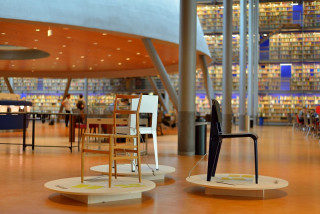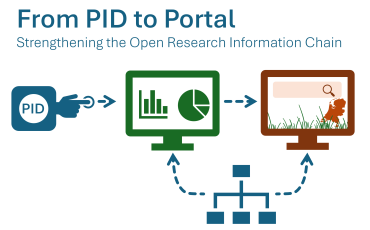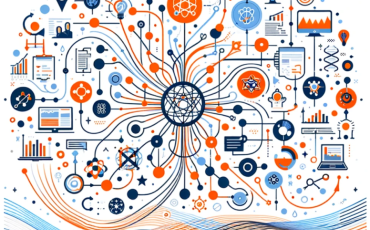
A fragmented map in an age of acceleration
Dutch research institutions produce excellent science—but much of the ecosystem remains difficult to navigate, both for humans and machines. Information is spread across disconnected systems, described in non-standard formats, or locked behind interfaces. Even within a single university or research hospital, answering simple questions like “What research is being done with this piece of infrastructure?” or “Which groups are working on AI ethics?” is surprisingly difficult.
This lack of a coherent, FAIR-aligned metadata infrastructure not only slows human coordination—it severely limits the ability of AI systems to contribute safely and meaningfully.
While the Netherlands has long invested in research information systems, open science infrastructures, and persistent identifiers, we have not yet made the leap to treating metadata about all research entities as a public, shared, interoperable foundation for the future of science.
FAIR metadata: from technical hygiene to strategic leverage
The principles of FAIR—Findable, Accessible, Interoperable, and Reusable—originated in the Netherlands and are now global. But applying these principles only to datasets and publications is no longer sufficient.
AI systems designed to accelerate discovery need to reason across the entire research landscape. That requires machine-actionable metadata about the full spectrum of research entities as captured in models like CERIF. This includes:
- Who: researchers, groups, departments, affiliations
- What: projects, publications, software, protocols, patents
- With what: instruments, facilities, funding streams, data
- Why and how: goals, methodologies, ethical dimensions
- For whom: societal partners, beneficiaries, impact pathways
A national, open, FAIR-aligned knowledge graph of research activity would not only enable AI-supported discovery—it would also enhance accountability, reduce duplication, support recognition and rewards policies, and improve the visibility of societal impact.
The Netherlands is ready—if we act together
We already have the building blocks:
- SURF and UKB provide technical infrastructure and collaborative governance.
- NWO, NFU, KNAW, and UNL are driving open science, recognition and rewards, and responsible research assessment.
- EOSC and European partners are advancing federated approaches that align with our values.
What we need now is a coordinated national effort to:
- Mandate FAIR metadata for all publicly funded research entities—not just outputs.
- Invest in a shared infrastructure layer for research entity metadata, built on existing CRIS, PID, and open standards.
- Ensure governance by public institutions, aligned with the academic core values of transparency, independence, and societal contribution.
- Enable AI systems to responsibly reason across the open research graph, under human supervision.
This is not an IT issue. It is a strategic question about the sovereignty, speed, and fairness of Dutch science in the AI era.
An open invitation to build the future
As professionals in libraries and research intelligence, we’ve spent years laying the foundations—curating metadata, aligning standards, building interoperability. We are ready to go further.
But the time for pilot projects and local optimizations is over. We need a national commitment to open research information as critical infrastructure, treated with the same urgency as digital identity, cybersecurity, or open access.
If we want Dutch science to lead in the AI age—not just follow—we must give both humans and machines a research map that is open, connected, and navigable.
The AI co-scientist is here. Let’s make sure the Dutch knowledge system is ready to collaborate.
Concept Policy Brief: Unlocking AI-Driven Science through Open Research Information
Date: June 2025
For: UNL, NWO, VH, KNAW, NFU, UKB, SURF, EOSC stakeholders
From: Dutch Research Intelligence Professionals
Summary
To prepare the Dutch research ecosystem for the era of AI-supported discovery, we recommend coordinated national action to ensure that metadata about all research entities—people, projects, outputs, infrastructure, funding, and impact—is open, FAIR (Findable, Accessible, Interoperable, Reusable), and machine-actionable. This is essential to enable the responsible use of emerging AI systems ("AI co-scientists") that can augment hypothesis generation, literature synthesis, and scientific innovation.
Key Issue
Current research infrastructures focus on open access to publications and data. However, metadata about research entities—as defined in the CERIF standard—remains fragmented, inconsistent, or closed. Without this layer of structured, connected information, both humans and AI systems are severely limited in their ability to:
- Navigate the research landscape
- Generate or validate novel hypotheses
- Coordinate interdisciplinary or interinstitutional efforts
- Evaluate societal impact and guide funding effectively
Urgency
Recent advances in AI (e.g. Gemini-based co-scientists) demonstrate the ability to:
- Generate novel, testable hypotheses in hours
- Recapitulate unpublished findings via structured reasoning
- Identify overlooked links between diseases, genes, and treatments
These systems rely on broad, machine-readable access to research information. Without open and FAIR metadata, such tools will remain narrowly siloed, and scientific acceleration will bypass public institutions.
Recommendations
We propose a national initiative to enable AI-readiness through open research information infrastructure. This requires:
- Policy Alignment
Mandate FAIR metadata for research entities in all publicly funded research (aligned with NPOS, EOSC, and CoARA principles). - Infrastructure Investment
Build a shared, federated knowledge graph infrastructure for research metadata, leveraging existing CRIS systems, PIDs (e.g. ORCID, DOI, ROR), and open standards (e.g. CERIF, DCAT, schema.org). - Public Governance and Stewardship
Ensure infrastructure is governed by public institutions, in alignment with academic values of independence, transparency, and societal contribution. - AI Integration Pilots
Fund proof-of-concept projects that use AI co-scientists in Dutch research domains (e.g. life sciences, sustainability, social sciences) using FAIR metadata from the shared hub.
Strategic Opportunity
This initiative strengthens the Dutch position in:
- Open Science leadership (NPOS, EOSC, UNESCO)
- Research evaluation reform (Recognition & Rewards, Open Knowledge)
- Digital sovereignty and AI ethics (Digital Europe, AI Act)
- Societal impact visibility (mission-driven innovation, SDGs)
Next Steps
We recommend establishing a taskforce under UNL/NWO/KNAW/SURF/UKB coordination to:
- Define a national metadata model for research entities
- Inventory existing infrastructure and gaps
- Propose governance and funding models (2025–2026)
- Begin phased implementation (2026–2028)



0 Praat mee